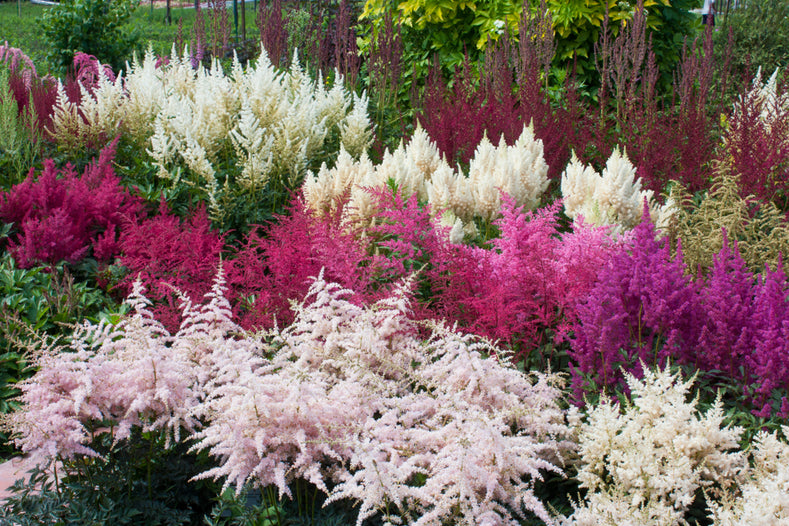Astilbe, also known as ‘False goat’s beard’ is a beautiful and versatile perennial plant known for its vibrant, feathery flowers and attractive foliage. It blooms flowers in various shades, from deep red to soft pink and lilac. They start blooming in mid spring and continue until the autumn, providing colour throughout the season. Astilbe are beautiful as border plants, ground cover, or however you choose to incorporate them in your shady garden. With its ability to thrive in shaded areas, Astilbe makes an excellent choice for adding colour and texture. Whether you're a seasoned gardener or a beginner, this guide will provide you with all the information you need to successfully grow Astilbe!
Plant your Astilbe roots in Spring once you have received them. Note that Astilbe take their time to emerge in Spring, but once they start shooting up they usually bloom throughout the season. They can even hold their fading plumes well into fall if you choose not to cut them off after they lose their colour. They are an excellent choice for adding a splash of visual drama in your garden, both with their bright blooms at peak and with their soft shades in the fading stages.
How to Plant:
- Choosing the Right Location: Astilbe plants prefer partial to full shade, although they can tolerate some morning sun. Select a location in your garden that receives dappled sunlight or where the plants will be shielded from direct afternoon sun. Additionally, ensure that the soil is moist and well-draining.
- Soil Preparation: Astilbe thrives in moist, organic-rich soil. Before planting, amend the soil with organic matter such as compost or well-rotted manure to improve drainage and fertility. It's advisable to work the soil to a depth of around 30cm to allow the roots to establish themselves easily.
- Planting: Astilbe is typically planted in spring. Dig a hole that is wide and deep enough to accommodate the root ball of the plant. Gently place the astilbe into the hole, ensuring that the crown (the point where the stems emerge from the root ball) is level with or slightly above the soil surface. Fill the hole with soil and firm it gently around the plant.
- Watering and Mulching: Astilbe requires consistent moisture to thrive. Water the plants deeply and regularly, especially during dry spells. Apply a layer of organic mulch, such as shredded bark or compost, around the base of the plants to help retain soil moisture and suppress weed growth.
- Fertilisation: Astilbe benefits from regular fertilisation to promote healthy growth and abundant flowering. Apply a balanced slow-release fertiliser in spring when new growth appears. Alternatively, you can use a liquid fertiliser diluted according to the package instructions during the growing season.

Caring for your Astilbe:
Maintenance: To keep your astilbe plants healthy and attractive, follow these maintenance tips:
- Regularly remove faded or dead flowers to encourage continuous blooming.
- Divide overcrowded clumps every three to four years in early spring or autumn to maintain plant vigour.
- Watch out for pests such as slugs and snails. Use organic pest control methods if necessary.
- In autumn, after the foliage has turned brown, cut back the stems to ground level.
Common Problems: Astilbe is generally a low-maintenance plant, but it can encounter a few issues:
- Insufficient moisture: Astilbe requires consistently moist soil. If the plants are not receiving enough water, they may wilt or fail to bloom.
- Sunburn: Direct afternoon sun can scorch the leaves of astilbe. Ensure the plants are adequately shaded to prevent sunburn damage.
- Powdery mildew: This fungal disease can affect astilbe, causing a powdery white coating on the leaves. Provide good air circulation and avoid overhead watering to prevent powdery mildew.

